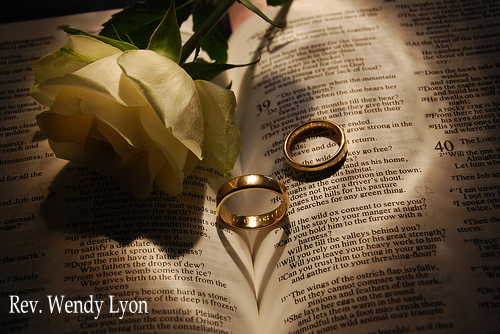

Tel: 518 882-6773
About my services
Ideas for your ceremony

- Unity Candle
- Hands of the Bride and Groom
- Sand Ceremony
- Rose Ceremony
- Love letters and wine box Ceremony
- Wine Sharing
- Memorial Candle
- New York marriage laws
- Fees and services
- Review and print my contract
- Visit the chapel
- Check availability
Other Services
Your wedding day
From my planning session, to the rehearsal, I will help you create a ceremony that's works best for you. Throughout the whole process, I will help you have a wedding ceremony is going to be exceptional.
Wedding planning absolutely must include environmental considerations that are an integral part of all wedding ceremonies.
Environmental factors to think about when planning your wedding day:
COMFORT
Both you and your guests must be physically comfortable for the duration of the ceremony. An outdoor wedding planned for a late Spring or an early Fall day, which turns out to be 56 degrees and drizzling can put a real damper on your ceremony. By the same token, a wedding taking place on a 85 degree August day directly in the hot sun will also be a problem. You and your guests will get the maximum enjoyment of your wedding ceremony only when they are within a comfortable environment. The more comfortable you and your guests are, the more every will enjoy your ceremony.
OTHER EVENTS AT THE SAME SITE
Clearly the best environment for a wedding ceremony is a location with no audio or visual distraction. Nothing should compete with you for those 30 minutes. An audience will always turn its attention to the most entertaining event within eye sight. When considering a setting for your ceremony always ask yourself what will compete with you at that location? Is it a busy restaurant serving other patrons or a park with a horse-shoe pit or a public park with visitors? It is important to choose an environment that will place the audiences' attention completely on your ceremony.
NOISE
Although seldom anticipated by couples planning their ceremonies, noise can and will:
1) remove the focus of your audience,
2) destroy the audio portion of your video taping and
3) may create a situation requiring the ceremony to stop.
Examples:
* Outdoor ceremonies held too close to large airports, the Northway
(I87)and other heavily traveled highways.
* Indoor air-conditioning or heating units that decide to kick on mid way through your ceremony.
* Outdoor ceremonies when the ground keepers or next door neighbors start up their lawn mowers.
* The neighbors' dog when it sees a stranger.
* Auto rewind cameras that your guests have brought and which now begin whirring away as they rewind the film during your vows.
* Babies or small children who begin crying and their parents will not move them to the rear.
* Cell phones.
* Banquet facilities that fail or forget to turn off their 'house music' during your ceremony.
Remember to ask yourselves... What are some of the things that might be distracting once my ceremony begins? Then plan ahead!
RAIN
If you are planning an outdoor ceremony you must have a backup plan in case of rain. Typically, couples having a large outdoor wedding and reception will have rented tents for that occasion. If it rains, the ceremony is moved under the canvas. Other couples, in the event of rain, will forgo the outdoor setting and have the ceremony at the waiting reception site. Whatever your plans might be: if you're having an outdoor wedding ceremony, you must make plans for rain.
A tent is not the best option. Watch this video to get an idea of what can happen.
Another serious consideration when having an outdoor wedding ceremony (if the outdoor ceremony site is in a different location than the reception) is when do you decide to move the ceremony site to the backup location and how do you let all the guests (and the Officiant) know that the ceremony site location has changed due to weather. This a problem if you are considering The Yaddo or Prospect Mountain in Lake George as your ceremony site.
If I have the privilege of being your officiant, I will need to know, well ahead of time, where else and at at what time your ceremony will take place once it's moved indoors.
This is a outline of the events during a basic ceremony
SEATING OF THE GUESTS.
The timely arrival of your guests is your first responsibility. Your invitation may need to include an easy to read map of where your ceremony and reception are taking place and the easiest ways of getting there. Music may be played while the guests are being seated. Discuss this with your musicians. They can make recommendations. Ushers direct guests to the bride's side or groom's side or they can invite people to be seated where ever they wish. This gives the
the audience a balanced look on both sides.
The entrance of VIPs as they are escorted to their seats is the first act of a wedding ceremony. Generally, grandparents are seated first, then step parents, followed by birth parents. When the bride's mother is seated the ceremony begins.
ORDER OF EVENTS
THE PROCESSIONAL
PRESENTATION OF THE BRIDE
INTRODUCTION AND OPENING REMARKS
THOUGHTS ON MARRIAGE
EXCHANGE OF WEDDING VOWS
EXCHANGE OF RINGS
CLOSING
DECLARATION OF MARRIAGE/PRONOUNCEMENT OF MARRIAGE
PROCESSIONAL
RECEIVING LINE
If you decide you would like to have readings, two readers are ideal for most ceremonies. One reader is associated with the bride, the other the groom. There reading can be placed before the vow or after the ring exchange, placement really depends on the reading. Prayers and blessing type readings usually follow the exchange of rings.